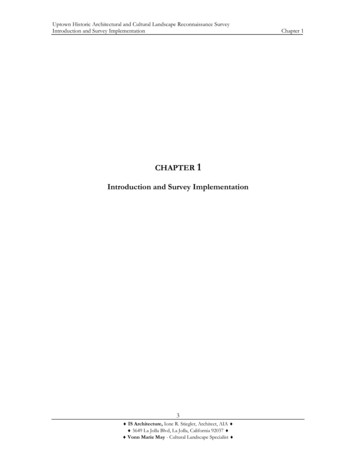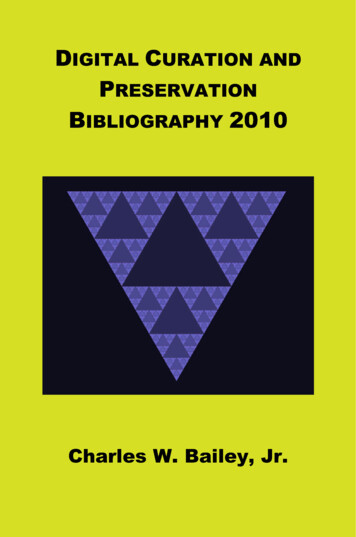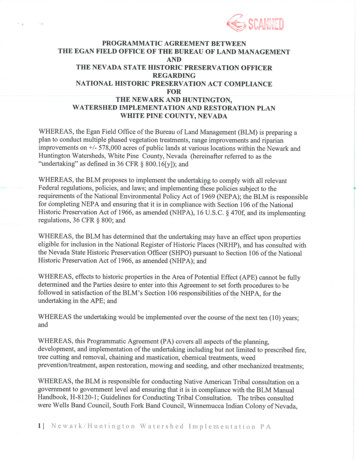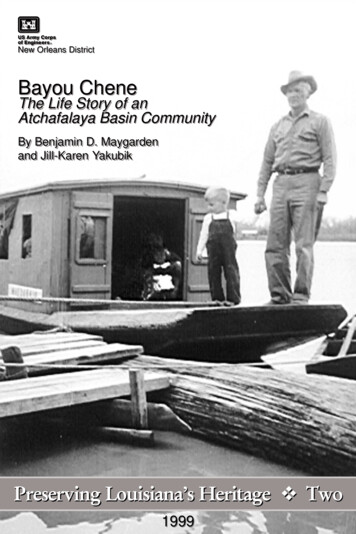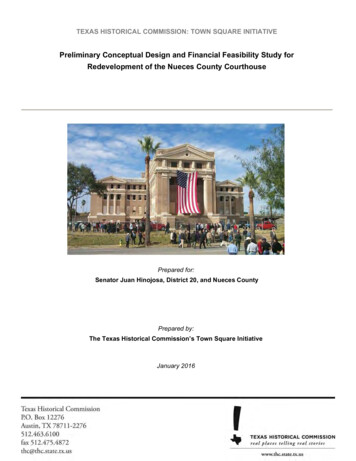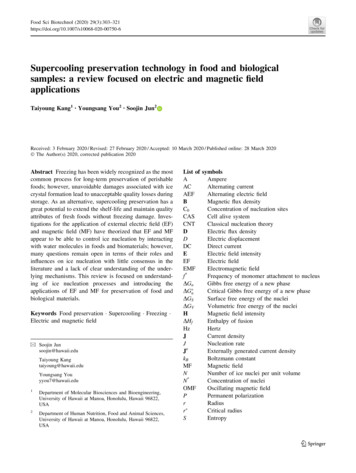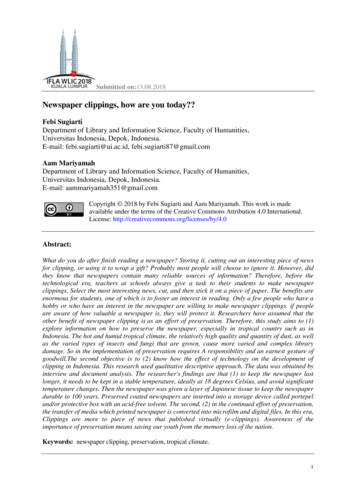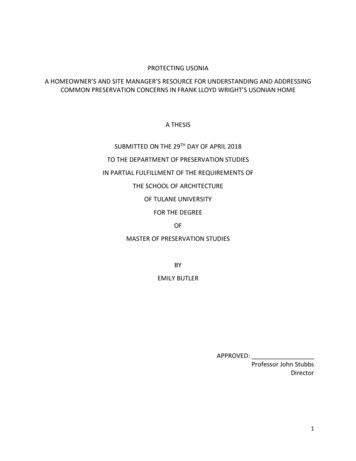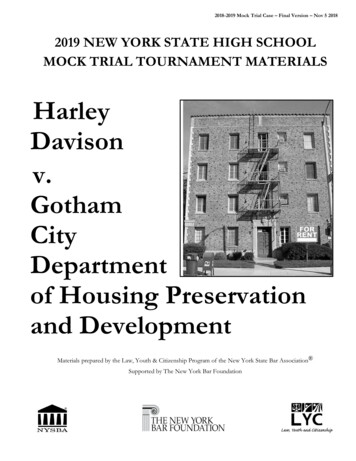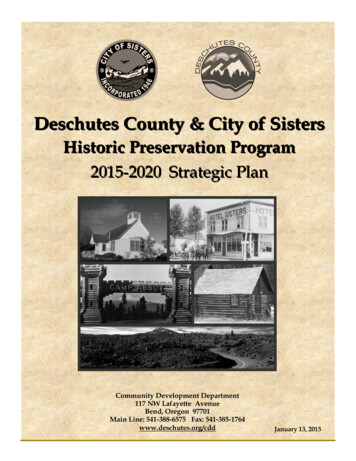
Transcription
Deschutes County & City of SistersHistoric Preservation Program2015-2020 Strategic PlanCommunity Development Department117 NW Lafayette AvenueBend, Oregon 97701Main Line: 541-388-6575 Fax: 541-385-1764www.deschutes.org/cddJanuary 13, 2015
AcknowledgementsPreparation of the Deschutes County and City of Sisters HistoricPreservation Strategic Plan was made possible through the cooperativeefforts of many public and private residents and stakeholders. DeschutesCounty and the City of Sisters extend their appreciation to all those thatparticipated and contributed to this process.Board of County CommissionersAnthony DeBone, ChairAlan Unger, Vice ChairTammy BaneySisters City CouncilChris Frye, MayorMcKibben Womack, PresidentDavid AssonWendy HolzmanNancy ConnollyHistoric Landmarks CommissionBroc Stenman, ChairSharon Leighty, Vice ChairChristine Horting-JonesDennis SmidlingKelly MaddonBill OlsenRay SolleyRachel StemachDeschutes County Planning StaffNick Lelack, AICP, DirectorPeter Gutowsky, AICP, Planning ManagerMatthew Martin, AICP, Associate PlannerCynthia Smidt, Associate PlannerCity of Sisters Planning StaffPauline Hardie, DirectorEric Porter, Senior Planner
I.Executive Summary . 4II.Overview . 5III.Background . 6IV.Historic Preservation Policies . 7Deschutes County . 7City of Sisters . 8V.Historic Resources . 9VI.Historic Resource Lists . 10Deschutes County . 10City of Sisters . 13National Register of Historic Places . 14VII. Plan Development . 15VIII. Plan Elements . 16APPENDIX-DIRECTORY . 18DESCHUTES COUNTY HISTORIC PRESERVATION STRATEGIC PLAN3
Executive SummaryThe Deschutes County and City of Sisters Historic Preservation Strategic Plan 2015-2020 provides aframework for shaping the county and City of Sisters’ preservation programs and services over thenext five years and creates a blueprint for allocating Certified Local Government (CLG) grantfunding. Currently, Deschutes County and its Historic Landmarks Commission (HLC), which alsoserves the City of Sisters, rely on CLG grants administered through the Oregon State HistoricPreservation Office (SHPO). They are awarded to eligible local governments in the spring of everyodd numbered year. The grant period lasts approximately sixteen to eighteen months. The grants,which require a 50/50 match are typically in the 10,000 to 14,000 range and used for a broadrange of preservation activities.Developing a Strategic Plan enables staff and HLC to reachout to our municipal partners, SHPO, historic landmarkproperty owners, stakeholders, and the public to prioritizepreservation programs that build upon existing projectsand promote collaboration. This effort also takes intoaccount finite in-kind resources from Deschutes Countyand Sisters. Both rely on their Community DevelopmentDepartment (CDD) to manage the CLG program and theHLC as outlined in the annual CDD work plan.To prepare this plan, Deschutes County staff solicited theguidance of a broad spectrum of people and organizations:community meetings provided opportunity for publicinput; stakeholder interviews were held to understandHLC Site Visit to Lynch and Robertstheir unique and qualified opinions; and an on-line surveyStore Advertisementwas established to provide additional feedback. The HLCfinalized ad supports the entire plan and its priorities and will review it annually to evaluate newimplementation opportunities and provide direction.The mission of the HLC is to preserve the City of Sisters and Deschutes County’s significanthistoric and archaeological resources and to encourage greater public understanding andappreciation.The plan identifies three goals, with associated objectives and actions, which are intended to guideand measure the success of the program:1. Collaborate: Strengthen the network of historic preservation and community partners throughcollaboration.2. Coordinate: Facilitate program administration and special projects that provide opportunitiesto expand the scope and benefits of the historic preservation.3. Educate: Promote educational opportunities highlighting the value, benefits, responsibilities, andrequirements of historic preservation.4DESCHUTES COUNTY HISTORIC PRESERVATION STRATEGIC PLAN
OverviewHistoric resources are recognized by Statewide Planning Goal 5, Natural Resources, Scenic Viewsand Historic Areas and Open Spaces, and Oregon Administrative Rule (OAR) 660-023. TheStatewide Goal and OAR recommend cites and counties inventory and protect historic and culturalsites. Recognizing the value and importance of having a connection to our past, Deschutes Countyand the City of Sisters have chosen implement and maintain a historic preservation program.What is a Historic Resource?Historic landmarks connect us to the past and teach us how people in different eras worked andinteracted within their surroundings. Historic resources are the buildings, structures, sites,districts, and large objects that have survived to the present. Examples include houses, cemeteries,bridges, camps, and archaeological sites. They are important because of their association withsignificant local, state or national themes, events, individuals or eras in history. They also includetraditional cultural places which are not obvious constructions because they are no longer presentbut continue to have significant meaning such as traditional Native Americans meeting places. Theselandmarks enrich the community by providing tangible evidence of our heritage.Why Preserve the Past?As described by the National Trust for Historic Preservation, historic preservation means savingthe story of us—the communities we cherish, the parks we love, the buildings we admire, the littlestories we always share with visitors. From ancient cultures through the growth of our currentcommunities, it is about saving the places, buildings, artifacts, stories and memories that preserveand enhance our human experience.2014 Historic Landmarks Commission (L-R Dennis Smidling, Rachel Stemach, Bill Olsen, Sharon Leighty, Broc Stenman,Christine Horting-Jones, Kelly Madden (not pictured: Ray Solley))DESCHUTES COUNTY HISTORIC PRESERVATION STRATEGIC PLAN5
BackgroundHistoric Preservation Program HistoryIn 1979, Deschutes County inventoried potential historic and cultural sites in the Resource Elementof the Comprehensive Plan. The 1979 Comprehensive Plan included goals and policies to protecthistoric resources as well as provisions that the County establish a HLC and adopt an ordinance toprotect designated historic sites.On September 17, 1980 the Board of County Commissioners adopted Ordinance PL-21, whichestablished an HLC and created a process to evaluate, designate and regulate historic structures.The HLC subsequently, and over time, evaluated proposed historic sites. The resulting list ofhistorically designated sites can be found in the Comprehensive Plans of Deschutes County and theCity of Sisters and on pages 7 and 8 of this plan. Starting in 1997, all historic and culturaldesignations were initiated at the request of property owners through the Comprehensive Plantext amendment process. The HLC serves as an advisory body for issues concerning historic andcultural resources for unincorporated Deschutes County and the City of Sisters and reviewsdevelopment applications for alterations to designated historic sites. In addition and specific toSisters, it reviews the exterior treatments of buildings applying the Western Frontier ArchitecturalDesign Theme.Since 2011, Deschutes County and Sisters reorganized and created their own program as a resultof the Cities of Bend, La Pine and Redmond wanting autonomy as an independent CLG.Map of Historic Landmarks Commissions in Deschutes County6D ESCHUTES COUNTY HISTORIC PRESERVATION STRATEGIC PLAN
Historic Preservation PoliciesDeschutes County Comprehensive PlanIn 2011, Deschutes County updated its Comprehensive Plan, apolicy document that provides a framework for addressing resourceprotection, rural growth and development over a 20 year period(2010-2030). The update was performed to ensure a consistentpolicy framework for land use planning and development thatreflects current conditions and trends, recent populationprojections, state law, and community values. The ComprehensivePlan goals and policies addressing cultural and historic resources aresummarized below.Section 2.11 Cultural and Historic Resources Goal andPoliciesGoal 1 - Promote the preservation of designated historic and cultural resources through education,incentives and voluntary programs.Policy 2.11.1 The Historic Landmarks Commission shall take the lead in promoting historic andcultural resource preservation as defined in DCC 2.28.a. Support incentives for private landowners to protect and restore historicresources.b. Support the Historic Landmarks Commission to promote educational programsto inform the public of the values of historic preservation.c. Support improved training for the Historic Landmarks Commission.Policy 2.11.2 Coordinate cultural and historic preservation with the Oregon State HistoricPreservation Office.a. Maintain Deschutes County as a Certified Local Government.b. Encourage private property owners to coordinate with the State HistoricPreservation Office.Policy 2.11.3 Encourage the preservation of lands with significant historic or cultural resources.a. Develop and maintain a comprehensive list of sites on the National Register ofHistoric Places.b. Review County Code and revise as needed to provide incentives and adequateregulations to preserve sites listed on the Statewide Goal 5 historic and culturalinventory.Policy 2.11.4 Goal 5 historic inventories, ESEEs and programs are retained and not repealed,except for the amendment noted in Ordinance 2011-003.DESCHUTES COUNTY HISTORIC PRESERVATION STRATEGIC PLAN7
Historic Preservation PoliciesCity of Sisters Comprehensive PlanThe Sisters Urban Area Comprehensive Plan includes the city ofSisters and an area surrounding the city which is expected tobecome urbanized by the year 2025. The basic purpose of theComprehensive Plan is to guide future development of the areawithin a framework of goals and policies which are consistent withthe physical characteristics, attitudes, and resources of the Sisterscommunity and to organize and coordinate complexinterrelationships between people, land, resources and facilities in amanner which will protect the health, safety, welfare andconvenience of its citizens. Sisters’ Comprehensive Plan goals andpolicies addressing cultural and historic resources are summarizedbelow.Goal 5: Open Space, Scenic and Historic Areas, Natural Resources5.1 Goal - “To protect natural resources and conserve scenic and historic areas and open spaces.”5.4 Policies.2. The City shall identify and protect historical sites within the Urban Growth Boundary.Tasks –a. The Sisters City Council has entered into an agreement with the Deschutes CountyLandmarks Commission to periodically investigate and identify historic sites within the CityLimits and study various means of interpreting local history.b. The Sisters City Council should review the policy relating to historical signs and plaques perCity Council action of October 9, 1980 (ORD. 138)c. The City should encourage the placement of heritage markers on historical buildings foridentification through the Development Code.d. Residential renovations and/or historic building designations (National Register of HistoricPlaces) should be promoted and encouraged by the City to help upgrade and preserve olderhousing stock.Historic Photo of Cascade Avenue, Sisters8DESCHUTES COUNTY HISTORIC PRESERVATION STRATEGIC PLAN
Historic ResourcesHistoric Resource DesignationThe Deschutes County HLC is part of a nation-wide network of groups dedicated to thepreservation and celebration of our heritage. The HLC is responsible for reviewing and maintainingthe Goal 5 list of designated historic resources. The resulting inventory of historically designatedsites is formally adopted in the Comprehensive Plans of Deschutes County and the City of Sisters.In addition, the National Register of Historic Places catalogs and protects properties worthy ofpreservation because of their significance to our nation’s history, architecture, landscape,archeology, engineering, and/or culture. As a CLG, the Deschutes County HLC is responsible foroversight of both the locally and nationally designated resources. Both are detailed on pages 10-14of this plan.Deschutes Landmarks Story MapAn ongoing goal of the preservation program has been to make historic resources more accessibleand engaging to interested parties. As technologies evolve, new opportunities are available tofurther this goal. One such technology is the ESRI Story Map. With assistance from a CLG grant,volunteer photographers from the Central Oregon Photography Club photographed all the listedhistoric landmarks located in rural Deschutes County and the city of Sisters. These photographsare incorporated into an interactive Story Map managed by the Community DevelopmentDepartment enabling viewers to learn more about the historic and cultural heritage of eachproperty. The website address is: deschutes.maps.arcgis.com/home. The mapping program allowsthe user to zoom in and out on the map pane to identify historic landmarks. Another option is totoggle between the photo list of structures, places, and sites. A click on the photo or the mappedmarker provides historic information and additional photographs of each site.The flexibility of the program will allow ongoing refinement and evolution to incorporate additionalphotos and expanded resource descriptions. The ESRI Story Map can also include addingarcheological sites or historic resources of other local jurisdictions to provide a comprehensiveresource throughout Deschutes County.Historic Landmarks Story MapDESCHUTES COUNTY HISTORIC PRESERVATION STRATEGIC PLAN9
Historic Resource ListsDeschutes County Goal 5 - Cultural and Historic ResourcesAlfalfa Grange: Grange building and community center, built in1930.Allen Ranch Cemetery: Oldest cemetery in Deschutes County.Fall River Fish Hatchery “Ice House”: The hatchery “IceHouse” dates from the beginning of fishery management inOregon, circa 1920.Alfalfa GrangeLong Hollow Ranch – Black Butte: Headquarters complex of historic ranch including headquartershouse, ranch commissary, equipment shed, barn and bunkhouse.Swamp Ranch – Black Butte: The present day site of the Black Butte Ranch was part of the vastholdings of the Black Butte Land and Livestock Company in 1904.Brothers School: Only one-room schoolhouse currently inuse in Deschutes County.Bull Creek Dam: The Bull Creek Dam, a component of theTumalo Irrigation Project was constructed in 1914 to form awater storage reservoir to increase the amount of irrigatedacreage at Tumalo.Brothers SchoolBull Creek Dam Bridge (Tumalo Irrigation Ditch Bridge): Builtin 1914, the bridge spans the Bull Creek dam. The structureis the oldest bridge in Deschutes County.Camp Abbot Site, Officers’ Club: Officers’ Club for former military camp, currently identified asGreat Hall in Sunriver.Camp Polk Cemetery: One of the last remaining pioneercemeteries.Camp Polk Military Post Site: One of the oldest militarysites in Deschutes County.Cline Falls Power Plant: Early hydropower site on theDeschutes River including dam, penstock and powerhouse.Cloverdale School: One-room schoolCloverdale. First building built in Cloverdale.buildinginCamp Polk CemeteryEastern Star Grange: Grange hall for earliest grange organized in Deschutes County.10D ESCHUTES COUNTY HISTORIC PRESERVATION STRATEGIC PLAN
Historic Resource ListsDeschutes County Goal 5 - Cultural and Historic Resources ContinuedEnoch Cyrus Homestead Hay Station and Blacksmith Shop:The original homestead of Oscar Maxwell, built in 1892 andpurchased in 1900 by Enoch Cyrus. Important stage/store stopfor early travelers.Fremont Meadow: A small natural meadow on Tumalo Creekused as campsite for 1843 Fremont expedition.Enoch Cyrus HomesteadHarper School: One-room schoolhouse.Improved Order of Redmond Cemetery: Historic cemeteryused by residents of La Pine/Rosland area.Laidlaw Bank and Trust: One of the few remaining commercial buildings from the community of Laidlaw.La Pine Commercial Club: Building was built in 1912 as acommunity center, serving as a regular meeting place for civicorganizations and occasionally served as a church. One of theoldest and continuously used buildings in La Pine.Lynch and Roberts Store Advertisement: Ad advertising signpainted on a soft volcanic ash surface. Only area example ofearly advertising on natural material. Lynch and Roberts established mercantile in Redmond in 1913.Laidlaw Bank and TrustMaston Cemetery: One of the oldest cemeteries in County. Oldest grave marker is 1901.George Millican Ranch and Mill Site: Ranch established in 1886.George Millican Townsite: Town established 1913. Site includesstore and garage buildings, which retain none of the architecturalintegrity from era.George Millican Ranch and Mill SitePetersen Rock Gardens: The Petersen Rock Gardens consist ofstone replicas and structures erected by Rasmus Petersen. Thesite has been a tourist attraction for over 60 years. (also on National Register of Historic Places)Pickett’s Island: After originally settling in Crook County, MarshAwbrey moved to Bend and then homesteaded on this island inthe Deschutes River south of Tumalo. The site was an early fordfor pioneers.Rease (Paulina Prairie) Cemetery: Historic cemetery on ElizabethVictoria Castle Rease and Denison Rease’s homestead.Pickett’s IslandDESCHUTES COUNTY HISTORIC PRESERVATION STRATEGIC PLAN11
Historic Resource ListsDeschutes County Goal 5 - Cultural and Historic Resources ContinuedTerrebonne Ladies Pioneer Club: The Club was organized in1910 and the building has been a community-meeting placesince 1911.Tetherow House and Crossing: Tetherow House was built in1878 and is the oldest house in the County. The Tetherowsoperated a toll bridge, store and livery stable for travelers.Terrebonne Ladies Pioneer ClubTumalo Creek – Diversion Dam: The original headgateand diversion dam for the feed canal was constructed in1914.Tumalo Community Church: The building is the oldestchurch in the County, built in 1905.Tumalo Project Dam: Concrete core, earth-filled dam wasfirst project by State of Oregon to use State monies forreclamation project.William P. Vandevert Ranch Homestead House: Thehomestead was established in 1892. Vandevert familyhistory in the area spans 100 years.Tumalo Community ChurchKathryn Grace Clark Vandevert Grave: Kathryn Grace Vandevert, daughter of William P.Vandevert, died of influenza during the epidemic of 1918.Young School: Built in 1928, it is an excellent example of arural one-room school which served homesteaders of the1920s.Agnes Mae Allen Sottong and Henry J. Sottong House andBarn: House and barn are constructed with lumber milled onthe property in a portable sawmill run by the Pine ForestLumber Company in 1911.Young School12DESCHUTES COUNTY HISTORIC PRESERVATION STRATEGIC PLAN
Historic Resource ListsCity of Sisters Inventory of Historic SitesAitken Drugstore: One of the few business buildings remaining from Sisters' disastrous fires in theearly 1920s.Hotel Sisters: Built in 1912 and had 19 rooms with amenities uncommon in the area at that time.Hardy Allen House: Early settlers of Central Oregon, the Allens built this house in 1908.Leithauser Store: The Leithauser Store was built in 1925 by Peter Leithauser and operated as hisstore until 1950.Historic Photo of Hotel SistersHistoric Photo of Aitken DrugstoreRecent Photo of Hotel SistersRecent Photo of Aitken DrugstoreDESCHUTES COUNTY HISTORIC PRESERVATION STRATEGIC PLAN13
Historic Resource ListsNational Register of Historic PlacesElk Lake Guard Station: A wagon road built in 1920 between Elk Lake and Bend sparked a wave of tourismaround the scenic waterfront. To protect natural resources of the Deschutes National Forest and providevisitor information to guests, the Elk Lake Guard Station was constructed in 1929 to house a forest guard.Paulina Lake Guard Station: The station typifies the construction projects undertaken by the Civilian Conservation Corps and signifies the aid to the local community provided by the emergency work‐relief program through employment of youth and experienced craftsmen, purchase of building materials andcamp supplies, and personal expenditures of enrollees.Skyliners Lodge: The Skyliners are a Bend‐based mountaineering cluborganized in 1927. In 1935, the group started building the SkylinersLodge with help from the Deschutes National Forest, the Economic Recovery Act and the City of Bend.McKenzie Highway: The McKenzie Salt Springs and Deschutes WagonRoad, a predecessor to the modern McKenzie Highway, was constructed in the 1860s and 1870s.Skyliners LodgeRock O’ The Range Bridge: Rock O’ The Range is the only covered span east of the Cascades in Oregon.To gain access to his property, William Bowen instructed Maurice Olson—a local contractor—to build abridge inspired by Lane County’s Goodpasture Bridge.Santiam Wagon Road: The Santiam Wagon Road went from Sweet Hometo Cache Creek Toll Station. The road was conceived of in 1859 to create aroute across the Cascades. By the 1890s the road had become a major traderoute.Deedon, Edand Genvieve Homestead: The homestead is located betweenthe Deschutes River and the Little Deschutes River. All of the buildings wereconstructed between 1914 and 1915.Santiam Wagon RoadGerking, Jonathan N.B. Homestead: Jonathan N.B. Gerking, “Father of the Tumalo Irrigation Project,”played a crucial role in getting the project recognized and funded.Paulina Lake IOOF Organization: The Paulina Lake I.O.O.F. Organization camp was constructed duringthe depression era and are the result of cooperative efforts by nonprofessional builders. Such camp buildings are important in Oregon’s recreational history as an unusual expression of both its rustic style and itsvernacular traditions.Petersen Rock Gardens: The Petersen Rock Gardens consist of stonereplicas and structures erected by Rasmus Petersen. The site has been atourist attraction for over 60 years.Wilson, William T.E. Homestead: This homestead house was built in1903 and has an “American Foursquare” architectural style.Original Sisters High School: In 1939, the construction of the SistersPeterson Rock Gardens14High School was constructed in 1939 and was financed with a PublicWorks Administration (PWA) grant. Its style, Colonial Revival, was oneof the most common architectural styles used for PWA schools.DESCHUTES COUNTY HISTORIC PRESERVATION STRATEGIC PLAN
Plan DevelopmentCommunity InvolvementDeschutes County values public involvement, recognizing it is a critical part of evaluating publicpolicy and land use planning processes. Understanding the perspective, goals, interests, andconcerns of the community allows decision makers to make informed decisions. Recognizing this,the Planning Division conducted an outreach campaign focused on historic preservation. In the fallof 2014, staff held three (3) community conversations in Bend and Sisters. Meeting announcements were provided in a variety of formatsto reach the largest population of interested parties* Press release to the media* Targeted mailings to listed Historic Property Owners* E-mail distribution to 15 stakeholders, several of which furtherdistributed the information to their network of members andpartners* CDD bi-monthly newsletter emailed to interested citizens andorganizations* CDD website, with links meeting and background information Meeting AnnouncementCommunity conversations used the same generalformat.*A PowerPoint presentation introduced the historyof historic preservation in Deschutes County,project background, and purpose of the meeting.*Open Forum providing attendees opportunity toshare ideas for future of historic preservationprogram.Community Conversation Power Point Slide Questionnaires and an informal survey were also utilized.* In addition to the open forum, all participants were provided an opportunity to complete aquestionnaire. This enabled participants to convey their thoughts privately.* Similar to the questionnaire, an on-line survey was created using the websitewww.surveymonkey.com to provide another opportunity to participate. A link to thesurvey was created on the County webpage directing and encouraging interested parties toprovide feedback. A total of 25 surveys were completed. Stakeholder Interviews*Stakeholder Interviews were held with individuals and interest groups to gather theiropinions and perspectives on Deschutes County’s historic preservation program. Staffcontacted 15 stakeholders and invited them to participate in a stakeholder meetingindependent of the community conversations. Staff met with the City of Bend HLC, City ofRedmond HLC, Deschutes Historical Society, State Historic Preservation Office, PatKliewer, and Michael Hall.DESCHUTES COUNTY HISTORIC PRESERVATION STRATEGIC PLAN15
Plan ElementsGoals, Objectives, and ActionsThe following goals, objectives and actions reflect a general consensus of those who participatedand the priorities of the Deschutes County Historic Landmarks Commission.GoalsThe goals are directly linked to the priorities expressed by thepublic, the HLC, the Sisters City Council, and the BOCC.GOALSObjectivesThe plan’s objectives describe elements of how the historicpreservation program will approach the goals. Several of theobjectives serve multiple goals but each is listed with its mostrelevant goal. Objectives are listed in rough priority order. Eachhas associated actions to implement.OBJECTIVESActionsThe plan’s actions detail how the objectives will be accomplishedover a 3 to 5 year time frame. Actions are listed as priorities andmay apply to multiple objectives but are described in relation totheir primary objective.Goal 1 - Collaborate:ACTIONSStrengthen the network of historic preservation and communitypartners through collaboration.Objective: Improve facilitation of Historic Preservation in the region to increase the visibility ofand participation in historic preservation efforts throughout the county.Actions: Establish the Des Chutes Historical Society as the hub of historic preservation programs. Support and engage in Historic Preservation Month activities.Objective: Work with other HLCs and stakeholder groups to maximize impact and value toowners and general community.Actions: Schedule annual meetings and/or presentations with other HLCs in the region. Create and maintain a calendar of historic related events throughout the county. Improve the management and access of historic property records in partnership with otheragencies and local museum resources through support for technology upgrades.16D ESCHUTES COUNTY HISTORIC PRESERVATION STRATEGIC PLAN
Plan ElementsGoal 2 - Coordinate:Facilitate program administration and special projects that provideopportunities to expand the scope and benefits of the historic preservation.Objective: Expand and Improve Historic Preservation Program Administration.Actions: Provide dedicated staff to facilitate and manage historic preservation program. Conduct an inventory of potential properties eligible for landmark designation. Enhance the Sisters/County focus in demonstrating best historic preservation practices. Enhance archeological focus on archeological sites in Deschutes County. Build oral history collection. Review and update relevant county codes for consistency with state laws and policies.Objective: Improve access to historic resource information.Actions: Regularly hold HLC meetings in Sisters and other regions of the county. Provide more content to the “Story Map” descriptions. Incorporate federal and archaeological sites into “Story Map” content. Support tech upgrades at Des Chutes Historical Society to overhaul outdated equipment. Complete scanning of historic property files located at the Des Chutes Historical Society. Create driving tour app similar to Bend Heritage Walking Tour app.Objective: Improve relationships with historic resource owners.Actions: Maintain regular contact with historic property owners such as scheduled mailers, phonecalls, and visits to highlight benefits and responsibilities of designation. Assign historic sites to landmarks commissioners to establish stronger relationships. Support annual BBQ as thank you for historic property owners.Goal 3 - Educate: Promote educational opportunities highlighting the value, benefits,responsibilities, and requirements of historic preservation.Objective: Expand historic preservation education.Actions: Conduct presentations throughout the county including
and measure the success of the program: 1.Collaborate: Strengthen the network of historic preservation and community partners through collaboration. 2.Coordinate: Facilitate program administration and special projects that provide opportunities to expand the scope and benefits of the historic preservation.
